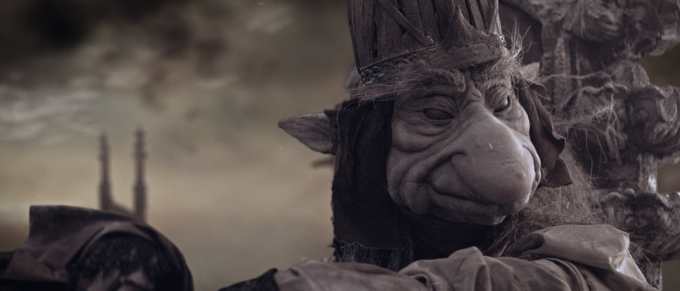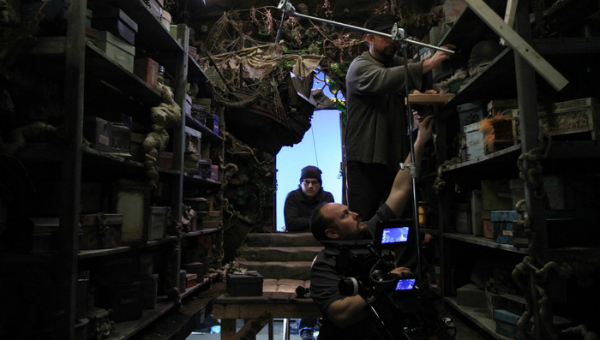
Toby Froud’s puppet fairytale LESSONS LEARNED is our favourite short film in the LIFE LESSONS strand at Cambridge Film Festival this year. Toby’s dad worked with Jim Henson’s Creature Shop as the concept artist for THE DARK CRYSTAL and also LABYRINTH, in which Toby co-starred. Toby now works for Laika Entertainment, a stop-motion and animation company in Portland, Oregon. Animator Harry Hunt spoke to him about his work and his Froudian/Hensonian heritage.
Harry Hunt: Congratulations on a magnificent directorial debut. How did you find the process of funding the film through Kickstarter?
Toby Froud: It was an amazing experience, I have certainly learned a lot from running the campaign. I went into Kickstarter not knowing whether it was going to work – I just knew I wanted to be honest and try to show my intention of how serious I was about this project. I think showing Digby, as he’s known now, was what really helped. By showing a character like that in the Froudian style, something that I feel people have wanted for years but really not seen since Labyrinth and The Dark Crystal, people were able to connect to the idea of puppets again.
HH: The relationship between grandfather and son reminded me of that between (Henson’s) The Storyteller, and his dog. Also, Mark Lewis’ delivery lent a similar wonderful, instant magic tone to the piece, backed up by the crackling of the fire. When you were writing the story, did you conceive it as a nod to the classic folk tales?
TF: I was certainly influenced by the Storyteller series, I loved those stories and the way Henson told them visually. I wanted that exact feeling – it was a nod to a nostalgia that I feel people are looking for. Beyond that, I love faerie tales and folk lore, fantasy and adventure, so drawing on all of that really shaped the world for me. Having Mark Lewis lend his voice to Grandfather was perfect. He is a storyteller by trade and I feel he captured the essence of the character brilliantly.
HH: Working with characters drawn in some respect from your parents’ canon, did you ever feel under pressure to do their world justice, or did collaboration come naturally?
TF: My parents and I have had a natural collaboration for a few years now. It feels natural creating characters in the Froudian Realm. I love to explore the world and see where it takes me. I certainly would keep showing and talking with my parents through the whole process of the film. We work so well together as a team and family that it’s always exciting to bounce ideas off of each other. My father also designed the Spider Fate character, which I then sculpted the head for. It was great to send pictures for him to see, and direct the feel of the character. I truly loved being able to do that.
HH: CGI is a touchy subject these days, on the one hand seeming to threaten the old ways of puppetry and stop motion, but at the same time generally paling in comparison. It was gratifying to see that only a very light touch of the mouse was evident here. Had you more time and money, would you have attempted to make it completely non-digital?
TF: I agree that CG has become a hot subject regarding characters and the over use of it to realise fantasy worlds. Filmmakers are relying far too heavily on CG to show the audience everything. The beautiful thing with a puppet is that it is real. Your mind knows that even if it is a puppet, it existed in the world – you could touch it if you were in the scene with it. That is a huge thing for people to believe. You don’t get that same feeling with a CG character. Also, when using a puppet you have to be creative with how you show it. There are so many things to think about. Even simply how you get the puppet to move from one point to another takes a lot of planning; you’re faced as a director with the challenge of showing only the bits of the puppet that look good. I feel they are great problems to have: as a director you end up with some quite amazing solutions, and in the end, fantastic shots. With all of this, though, I do feel CG has its place. I feel it should be used to expand the world to give more to a physical element. We shot the King’s scene for LESSONS LEARNED against green screen. The King and the stone walkway, the pillars and the Spider character were all there and very real, but the storm surrounding the whole scene was comped in later. We had an amazing VFX guy, Adam C Sager, who comped everything; and David Manuel, a brilliant digital artist who expanded the King’s world to really give it the sense of scale that I was looking for. If I had more budget to work with, I would have done more of that. I hope to use miniatures and other tricks to create larger worlds. But I would always use modern comp and computer technology if I could to enhance a scene. As long as I have a physical puppet in the middle.
HH: Assuming you will return to the world of faeries and goblins in future, would you be tempted, working at Laika, to bring the creatures to life in stop-motion, or do they “belong” in the puppet world?
TF: I certainly intend to carry on in the realm of Faeries, creatures and goblins. It’s where I feel most comfortable. I would certainly use stop motion to realize some creatures if I get the opportunity too. Working at Laika is a great experience and the characters we bring to life there are amazing.
HH: This film completed, how big is your lessons learned box now?
TF: I have to say my lessons learned box is massive now. I learnt and grew through this whole process, its been a fantastic journey. I have had so much love and support from people who funded the project through Kickstarter, to the amazing crew that stuck by me and the idea through the creative chaos. I can’t wait to do it again, I’m certainly ready too, but I will be wheeling my trunk of lessons with me – ready to put more into it.
LESSONS LEARNED screens as part of the LIFE LESSONS short film strand at 20.20 on 2nd Sep and 23.00 on 3rd Sep at Cambridge Arts Picturehouse.
httpvh://vimeo.com/97022699

